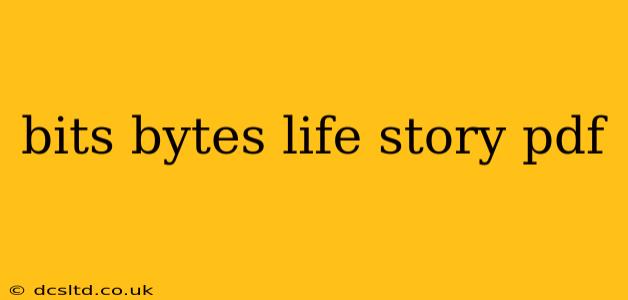The Enigmatic Life Story of Bits and Bytes: A Deep Dive into Digital History
The phrase "bits and bytes" is ubiquitous in our digital age. We hear it tossed around in conversations about internet speed, data storage, and computer processing power. But what's the actual story behind these seemingly simple terms? Their history is far richer and more fascinating than most realize, intertwining with the very evolution of computing itself. This exploration will delve into the origins, evolution, and enduring significance of bits and bytes, unraveling their life story from the early days of computing to their current omnipresence.
What are Bits and Bytes? A Fundamental Explanation
Before diving into their history, let's establish a clear understanding of these fundamental digital units. A bit, short for "binary digit," is the smallest unit of data in computing. It represents a single binary value: either 0 or 1. Think of it as a light switch—either on (1) or off (0).
A byte, on the other hand, is a group of eight bits. This combination allows for a much wider range of representation, enabling the encoding of letters, numbers, and other symbols. The byte is the foundational building block for representing more complex data structures.
The Genesis of Bits and Bytes: Early Computing and Binary Code
The concept of bits and bytes isn't the brainchild of a single inventor but rather emerged organically from the very nature of digital computing. Early computers relied on binary code because it was the simplest and most reliable way to represent information using electronic switches—the "on" and "off" states perfectly mirroring the 1s and 0s of binary.
The choice of eight bits to form a byte wasn't arbitrary. Early computer architects found it a practical size for representing characters using standard character sets like ASCII (American Standard Code for Information Interchange). ASCII used seven bits to represent 128 characters, and the eighth bit was initially used for error detection.
The Evolution of Bytes and the Expanding Digital World
As computing technology advanced, the capacity and sophistication of bytes increased. The emergence of extended character sets, capable of representing characters from various languages, necessitated the use of more than eight bits. This led to the development of multi-byte character sets like Unicode, which uses a variable number of bytes (up to four) to represent a wider range of characters globally.
The evolution of bytes parallels the evolution of computer architecture and the explosive growth of data. From kilobytes (KB) to megabytes (MB), gigabytes (GB), terabytes (TB), petabytes (PB), and beyond, the prefixes reflect the exponentially increasing capacity of data storage and processing.
How Bits and Bytes Shape Our Digital Lives
Bits and bytes aren't just abstract concepts; they are the invisible threads weaving together the fabric of our digital lives. Every image we see, every email we send, every video we stream, and every line of code that powers our applications is ultimately a vast collection of bits and bytes. Their significance lies in their ability to represent and manipulate information with incredible precision and efficiency.
Are there different types of bytes?
While the fundamental definition of a byte remains consistent—eight bits—the practical application can vary slightly depending on the system's architecture and data representation. Different systems might handle bytes with subtly different internal structures or byte ordering (endianness), although these differences are typically transparent to the end-user.
What is the future of bits and bytes?
The future of bits and bytes is likely tied to continued miniaturization and increasing processing power. We can anticipate further advancements in data storage and processing technologies, potentially leading to even smaller and more efficient units of data representation, although the fundamental concept of bits and bytes as the building blocks of digital information is unlikely to change.
Conclusion: The Enduring Legacy
The life story of bits and bytes is a compelling narrative of technological advancement. From humble beginnings as binary digits representing simple on/off states, they have evolved to become the fundamental building blocks of our interconnected digital world. Their story continues to unfold as technology relentlessly progresses, promising even more groundbreaking innovations in the years to come. Understanding their significance allows us to appreciate the intricate complexity underlying the seemingly effortless digital experiences we take for granted.
